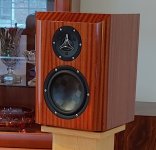Kimmosto original posting of the 1.2-1.4 wl c-c was around beginning of 2021, not sure what the first post was, its on thw htguide, ASR or here, probably mentioned in all. See this for example https://www.audiosciencereview.com/forum/index.php?threads/some-help-with-lobing.22661/post-753404
If one plays with VituixCAD its quite natural to come up with such c-c spacing with conventional multiway speaker. I'd imagine its application dependent if it works or not.
I see it a blessing for designer, freedom. Better to make the new found space available in bigger c-c in good use, its a design freedom and its silly not to take advantage of, especially if it sounds better 😉
If one plays with VituixCAD its quite natural to come up with such c-c spacing with conventional multiway speaker. I'd imagine its application dependent if it works or not.
I see it a blessing for designer, freedom. Better to make the new found space available in bigger c-c in good use, its a design freedom and its silly not to take advantage of, especially if it sounds better 😉
Here is an example of a 2-way speaker with the drivers spaced closely together. It is a 6" midwoofer and a 1" tweeter, and the CTC distance is 146 mm, which means there is only 11 mm between the tweeter flange and the midwoofer frame.

There is a 3 to 4 dB dip in the power response between 1k and 2k.
If the drivers were spread vertically, the performance would improve. If the vertical distance between the drivers was increased by 110 mm, to a total CTC distance of 256 mm, this would be the result. 256 mm CTC is equivalent to 1.2 x the wavelength of the crossover frequency (1600 Hz).

Now the dip in the power response is only about 1 dB. The first example had a pronounced vertical null at 90 degrees, and now it is reduced.
j.
There is a 3 to 4 dB dip in the power response between 1k and 2k.
If the drivers were spread vertically, the performance would improve. If the vertical distance between the drivers was increased by 110 mm, to a total CTC distance of 256 mm, this would be the result. 256 mm CTC is equivalent to 1.2 x the wavelength of the crossover frequency (1600 Hz).
Now the dip in the power response is only about 1 dB. The first example had a pronounced vertical null at 90 degrees, and now it is reduced.
j.
I didn't say vertical response isn't compromised. It depends where the designer places their emphasis.Looks exactly as expected - a huge hole appears around the mid-tweeter crossover frequency when you become only slightly off the vertical axis. The horizontal power response depends on the drivers used so this case is more coincidental than a valid rule of thumb. If you use a 2" dome to cover up to 2kHz instead of a 7" midwoofer then you'll be solving a problem that doesn't exist. There is no guarantee that power response in a room matches anechoic measurements either, so you may be making compromises over how much sound is radiated to the sides when that sound may be entirely nulled out in a real room anyway.
I wouldn't be compromising what happens in the first 30-45degrees off axis in the vertical directions, just to provide a minor improvement to the calculated power response. You don't want all the vocals to disappear into a black hole whenever you change from a seated to standing position.
We all know optimising in one aspect of speaker design is always, always a compromise in another.
A mass market speaker has to balance both. You have no clue about listening distance nor room treatment / dimensions nor speaker placement.
